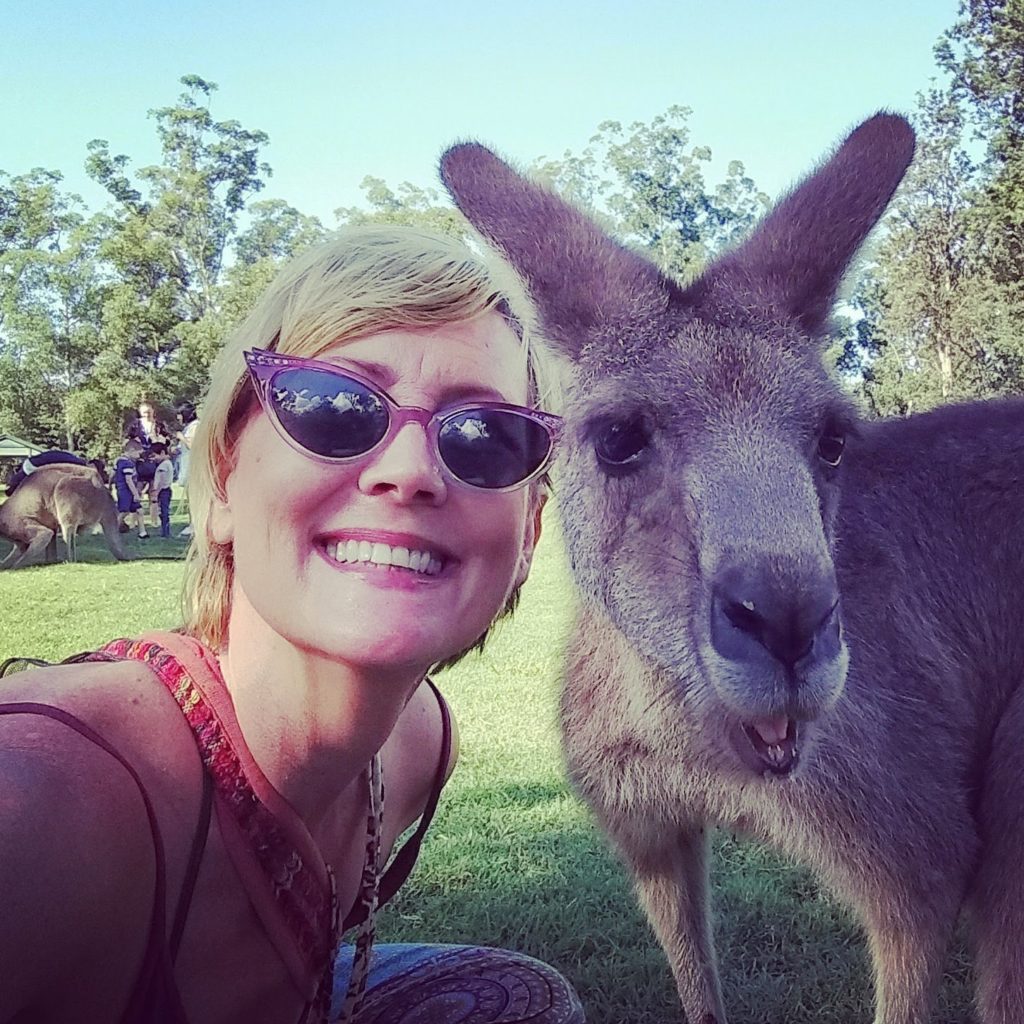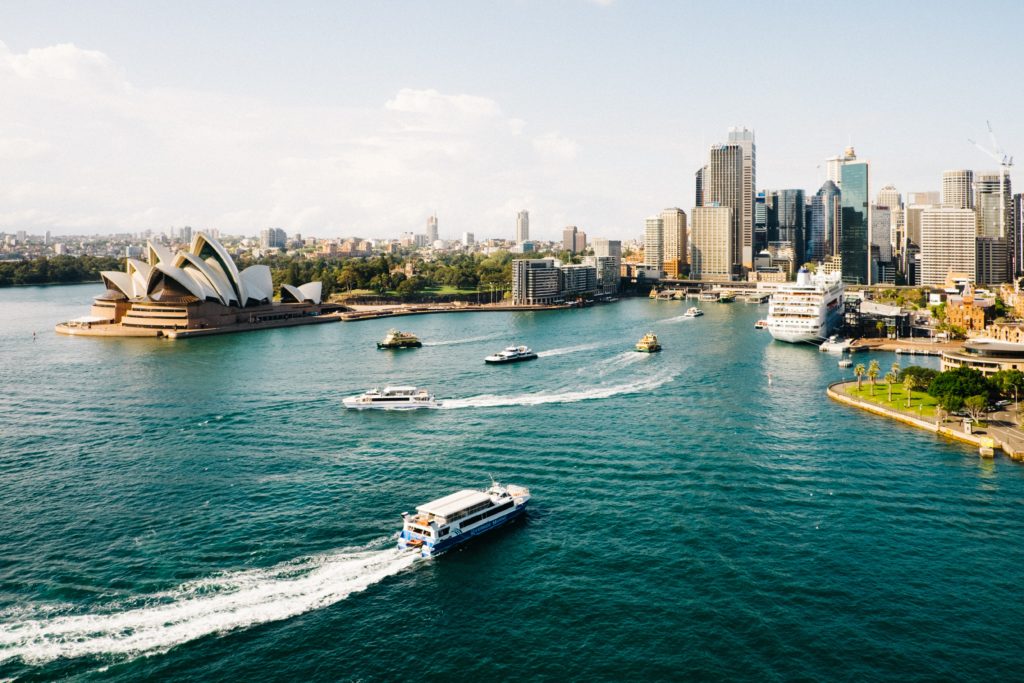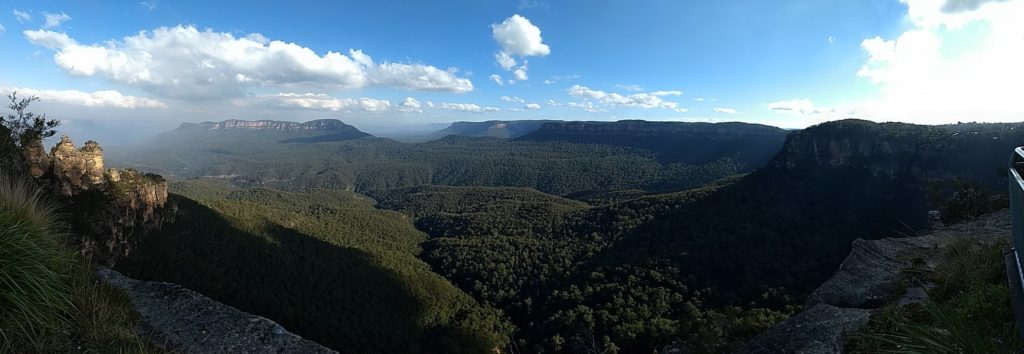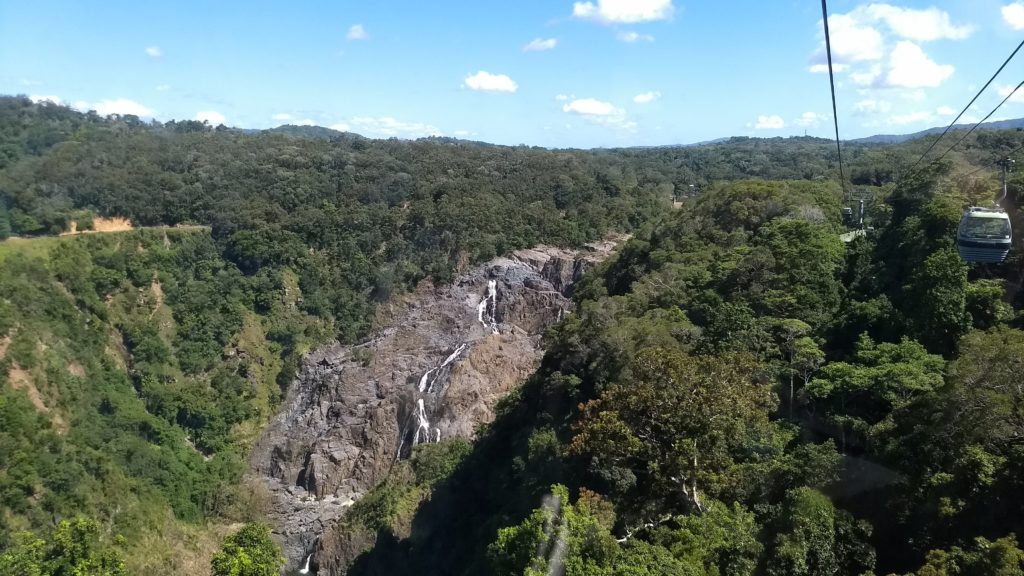Bridge climbing, koala snuggling, reef wonders and rainforest beauty abound, mate!
By Shelley Seale, Photos by Shelley Seale, Sydney Harbor Photo by Dan Freeman
During a trip Down Under, there are so many different types of places and experiences to be had that it can be difficult to decide just what to do. In my three weeks in Australia recently, I decided to stick to the East Coast rather than spread myself too thin (with plans to go back and discover other parts of the amazing country). Even with limiting myself geographically, there was much to see and do. Come along with me on the journey!
Sydney, New South Wales
Most international travelers begin or end their Australian journeys here. One of the most beautiful cities in the world, Sydney has an iconic skyline, which features the Harbour Bridge and the unmistakable Opera House, recognizable to almost anyone.
I began my first full day here, which is Australia’s No. 1 tourist attraction for good reason. As American architect Frank Gehry said, this unique architectural masterpiece “changed the image of an entire country.”
Danish architect Jørn Utzon designed the Sydney Opera House after winning an international competition held in the mid-1950s to select the plans for the new building. In the modernist style of the era, Utzon’s sculptural design, which resembles either wings or the sails of a ship, depending on the eye of the beholder, seemed ahead of its time.
Sadly, Utzon never saw the completed Opera House with his own eyes; as construction pressures mounted, Utzon left Australia midway through the building process, never to return to see the project completed.
I highly recommend a guided tour for the incredibly interesting story and a behind-the-scenes look at the interior, which is somewhat unmemorable, compared with the exterior, but the details are fascinating. Afterward, you might want to grab a bite or a drink at the Opera Bar, which boasts some of the best views of the harbor, including the little ant-like figures of people climbing across the top of the bridge across the bay, which was to be my next adventure.
 Not for the faint of heart, this is an adrenaline-rush experience that is not nearly so scary as it seems once you’re up there. BridgeClimb Sydney is the company behind this, and it’s a pretty impressive operation. A large facility and highly trained, experienced staff lead you every step of the way, from suiting up to practicing on the indoor rails, ladders and catwalks.
Not for the faint of heart, this is an adrenaline-rush experience that is not nearly so scary as it seems once you’re up there. BridgeClimb Sydney is the company behind this, and it’s a pretty impressive operation. A large facility and highly trained, experienced staff lead you every step of the way, from suiting up to practicing on the indoor rails, ladders and catwalks.
Headsets connect everyone, and I have to admit my heart was beating fast as we were harnessed onto the steel cables and set out across the first catwalk and ladders that go up to the base of the bridge. This was a nice, easy practice to calm the nerves and realize that, hey, it’s a lot like just walking.
Geared up, I clipped in with steel cables dozens of feet above the ground and prepared to climb up nearly 450 feet above Sydney Harbor to stand at the very top of the arch. Along the way, the guides gave interesting tidbits about the construction of the bridge and the city itself, along with a few corny jokes.
Most of the ascent and descent are easy steps, so it’s really not as difficult or scary as it sounds like it might be. I have to admit, however, that standing at the very top and looking down between the steel beams to the traffic below—and the water even further below that—was an awe-inspiring moment.
When it comes time to kick back and relax, Sydney has some great beaches. Bondi and Bronte are two other very popular spots, but a trip by ferry to Manly is a quintessential Sydney experience. It’s sort of the Australian version of the Staten Island Ferry in New York City. The ferries leave from Circular Quay in the harbor, run frequently and only cost about $7 Australian. (You can use the Opal card, which is also good on the buses and trains.)
The 30-minute trip offers some of the best sightseeing and photography views of the city from the water, and sometimes you can see dolphins along the way. Plan to come back into Sydney by sunset for a magnificent Instagram-worthy scene.
Arriving in Manly, the beach is a really easy walk along a wide boardwalk called The Corso, which is lined with shops and eateries and is only a few blocks from the wharf. You can swim, hang out on the beach, surf (There is a surf school and board rentals are available.) or stroll along the Cabbage Tree Bay Eco Sculpture Walk to other beaches, including Shelly Beach at the other end of the path.
Eating is a treat in Sydney. From world-class restaurants to stalls along the quay, in Chinatown or at the fish market (a must-visit spot), this is a city with an almost endless array of international cuisine at your fingertips.
Check out Tourism Australia’s Guide to Sydney for more great ideas.
Blue Mountains
This stunning World Heritage region is densely forested, with peaks and valleys that definitely cast a blue hue against an often misty sky. We rented a car for the day, but you could also easily take this trip by train, as station stops are at several of the major sites. Or take a tour coach or public bus there.
The Three Sisters is the Blue Mountains’ most spectacular landmark, located in the town of Katoomba. This rock formation with three peaks jutting majestically more than 900 meters into the sky is named from an Aboriginal legend, which has it that three sisters, Meehni, Wimlah and Gunnedoo, were turned to stone.
The lighting of the Three Sisters changes throughout the day, including being lit by floodlights until 11 p.m., making different and spectacular views at various times. You can also take a little pathway down to the Giant Stairway and Honeymoon Bridge, which leads out to a tiny, towering rock outcropping that’s visible from the observation platform above Three Sisters.
Some of my other favorite spots in the Blue Mountains were Wentworth Falls and the charming town of Leura, filled with cute little shops, bookstores, cafés and cultural venues. If you want to make an overnight trip of the Blue Mountains, Leura would make a most charming place to spend the night.
Check out Tourism Australia’s Guide to the Blue Mountains for more great ideas.
Brisbane, Queensland
Just an hour and a half flight from Sydney, Brisbane isn’t as large and therefore, is more manageable. But it’s still a vibrant, cosmopolitan city in its own right. A great way to get started making Brisbane’s acquaintance is by taking a free Brisbane Greeters tour, led by locals who love their city and love showing it off to visitors.
 A major highlight of my entire time in Australia was the Lone Pine Koala Sanctuary. It’s one of the best anywhere, and is the world’s first and largest sanctuary for koalas, with about 130 of the adorable creatures.
A major highlight of my entire time in Australia was the Lone Pine Koala Sanctuary. It’s one of the best anywhere, and is the world’s first and largest sanctuary for koalas, with about 130 of the adorable creatures.
Like good wildlife-conservation organizations, there is a major environmental and educational component at Lone Pine. A large number of unique-to-Oz creatures reside here, from the koalas to kangaroos, wallabies, platypuses, kookaburras, Tasmanian devils and more. A variety of interactive talks and shows are held each day, such as the Raptor Free Flight, Sheep Dog show, Koala Keeper talk and more.
But the absolute best part of the day there came in two opportunities: actually holding a koala and getting my photo taken with it, and hand-feeding the kangaroos, which are plentiful here.
Check out Tourism Australia’s Guide to Brisbane for more great ideas.
Great Barrier Reef
It’s the biggest single structure made from living organisms on the planet, so large that it can be seen from outer space. The world’s largest coral reef system, the Great Barrier Reef is made up of more than 2,900 individual reefs and 900 islands, stretching for more than 1,400 miles off the coast of Australia.
Called “Australia’s great natural wonder,” the Great Barrier Reef was named a World Heritage Site in 1981, and labeled one of the seven natural wonders of the world. It supports a huge diversity of life, and the excitement of witnessing that up close and in person through diving and snorkeling is an opportunity that’s hard for nature lovers to pass up. Even if you don’t dive or swim, there are ways to experience the reef through adventures like submarine-like viewing pods, glass-bottom pontoon boats and kayaks and the like.
There are lots of tour operators that offer day trips to the reef, enabling people to visit it in a short amount of time. Consider various day trips to have unique experiences.
From Cairns, I took off with Raging Thunder for its Fitzroy Island Adventure, a full-day tour that visits Fitzroy, which was once part of the mainland before breaking off long ago, via a one-hour catamaran ride. Once at the island, you can get snorkel gear to go out on your own or a guided snorkel tour with staff guides. There are also options like a combination sea-kayak-and-snorkel tour, along with snuba, a newish water sport that allows people to experience diving short distances underwater while connected at all times by air hose to the tank at the surface.
I started my day at Fitzroy by walking through the rainforest for about 20 minutes to Nudey Beach (which is not named that for what you’re likely thinking). This is a beautiful, white coral beach with little alcoves and places to snorkel, though there isn’t as much to see here as around the other side of the island, where big rocks host a lot more reef life. Pro tip: If you come here or to many places around the reef, bring water shoes. The beaches are made up largely of broken-off bits of coral, which can really hurt your feet to walk on.
I was amazed by how beautifully aquamarine the water was, how pristine and white the beaches were, how lush and green the trees and other flora were. After some time at Nudey Beach, I walked back around to the main pier and Raging Thunder’s activity hut to pick up my box lunch the company provided. After my picnic at the water’s edge, I walked down the other way along the coastline to snorkel among the rocks. Here, the sea life was plentiful, with lots of parrot fish, clown fish and some of the biggest brain coral and cabbage coral I’ve ever seen. And I even saw a shark—a small white-tip reef shark about 3 feet long, who shyly zipped away a moment after I started following it.
Other activities at Fitzroy include stand-up paddleboarding, jumping on a water trampoline and taking in a glass-bottom-boat tour. There is also a half-day tour available for $79 Australian, but for $84 Australian, the full-day tour is a much better bargain.
I had a completely different reef day-trip experience the following week with Cruise Whitsundays, from Hamilton  Island, where I was staying at the luxurious Qualia Resort. After boarding the ferry from the Hamilton pier, it was two hours out to the company’s own anchored pontoon boat at Hardy Reef, 39 nautical miles out, with amenities such as undercover seating and tables, sun decks for topping up the tan, freshwater showers, change rooms and full access to the air-conditioned comfort of our reef vessel. Most importantly, there’s access to view the reef and its life: diving, snorkeling, a submarine with glass viewing windows that will take guests around the reef and even an underwater viewing station. All of this makes the reef and its life viewable to just about anyone of any capability, even those who don’t get in the water.
Island, where I was staying at the luxurious Qualia Resort. After boarding the ferry from the Hamilton pier, it was two hours out to the company’s own anchored pontoon boat at Hardy Reef, 39 nautical miles out, with amenities such as undercover seating and tables, sun decks for topping up the tan, freshwater showers, change rooms and full access to the air-conditioned comfort of our reef vessel. Most importantly, there’s access to view the reef and its life: diving, snorkeling, a submarine with glass viewing windows that will take guests around the reef and even an underwater viewing station. All of this makes the reef and its life viewable to just about anyone of any capability, even those who don’t get in the water.
A coral wall, home to an ecosystem of magnificent corals and marine life, runs adjacent to the pontoon. Hundreds of fish species gather here, giving the reef that magical feel in an intricate garden of hard and soft coral thriving in sheltered lagoons. The bright colors and amusing antics of anemone, parrotfish and sometimes even turtles and reef sharks captivate all. It is common to see tusk fish, cuttlefish, morays, barracudas, unicorn fish, surgeonfish, angelfish, starfish, feather stars and much more.
Thanks to the Cruise Whitsundays Introductory to Dive experience, you don’t need to be certified to dive. I’m not, although I have been diving before in similar learn-to-dive programs. With this intro package, people who have never been diving before or are nervous about it can feel at ease. All of our equipment was provided and taken care of, and the instructors/guides were with us at all times at a ratio of two divers per guide, meaning they are available to hold your hand if you need it!
After suiting up with equipment, we traipsed down the stairs to the underwater pool and access point. While we held onto a metal bar in the center, the instructors showed us how to use our breathing tubes, what to do if we got water in our masks and other fine points of the dive. We all practiced breathing underwater there and set out. It was really magical under the water. The reef was fairly vibrant, and immediately, tropical fish surrounded us, including some huge groupers.
Check out Tourism Australia’s Guide to the Great Barrier Reef for more great ideas.
Australian Rainforest
It’s not just the sea that holds such appeal here for nature lovers. Australia’s ancient rainforest covers more than 900,000 hectares and is millions of years old, a combination that offers some of the most breathtaking beauty to be found.
We took the Skyrail Rainforest Cableway to Kuranda, a small artsy village in the middle of the forest. The Skyrail is a unique opportunity to get a birds-eye view of the rainforest from a cable car high above. The cars stop twice before reaching Kuranda, and at these stops, you can get off and walk along a provided path and boardwalks for incredible overlook viewpoints. Rangers also give guided informative walks at these stations.
Arriving in Kuranda, take some time to explore this lively and fun village. Walking from the Skyrail station, there are plenty of restaurants, shops and markets along the way. If you walk all the way to the end of town, you’ll come to the Original Rainforest Market, which I thought was the best place to visit. It’s full of really quirky little cafes and shop stalls selling all manner of handmade items, from clothing and jewelry to soaps and artwork.
To go back, we elected to take the Kuranda Scenic Railway. Taking the Skyrail one way and the train the other makes for a varied and fun day. The historic railway was established in 1891, and the refurbished railway cars definitely have that heritage feel. Rising from sea level to 328 meters, the journey winds through a tropical paradise framed by rugged mountains with waterfalls tumbling forever into deep ravines. There is a narrated commentary of information, with snacks and drinks available on board.
Check out Tourism Australia’s Guide to the Daintree Rainforest for more great ideas.











